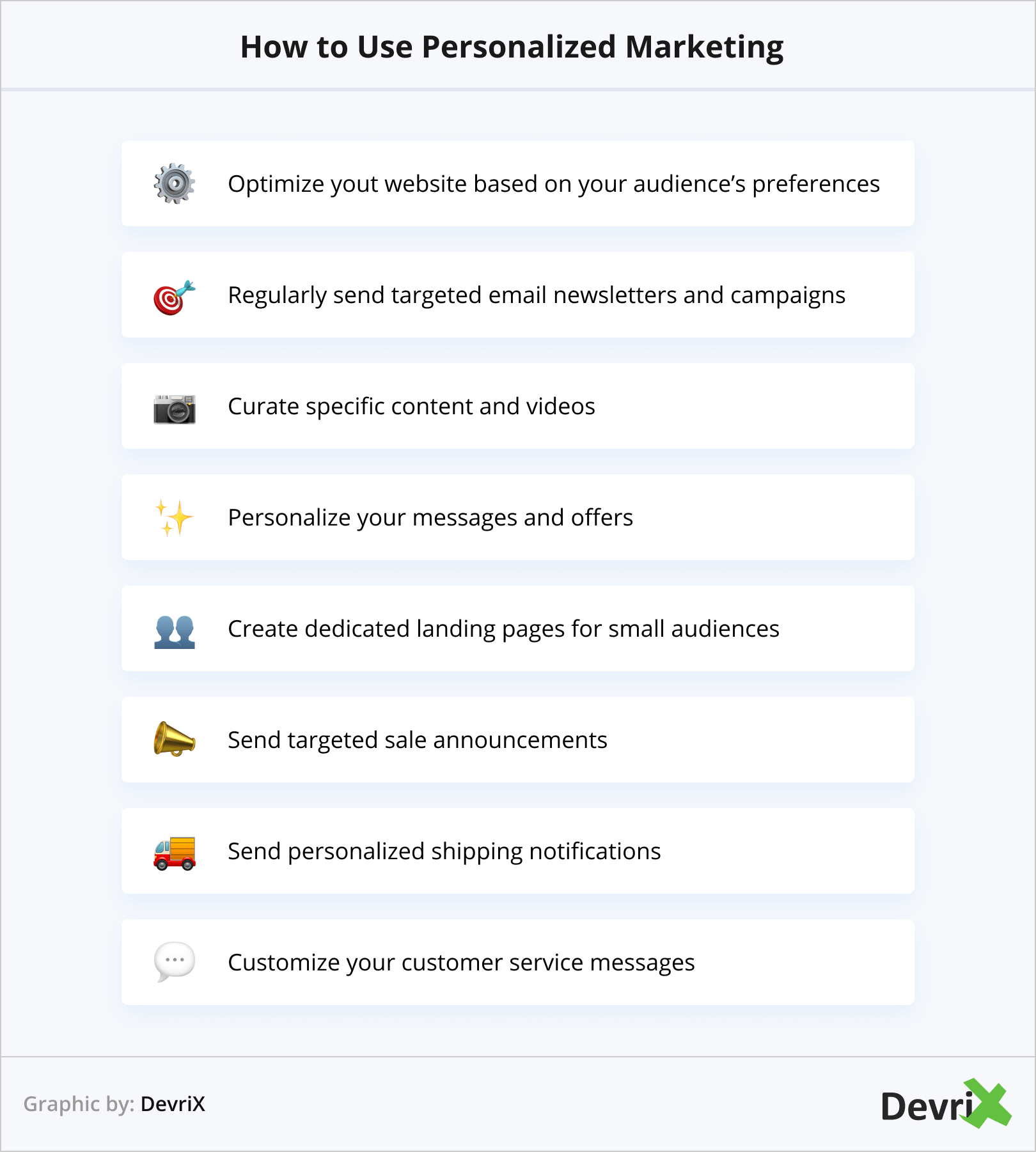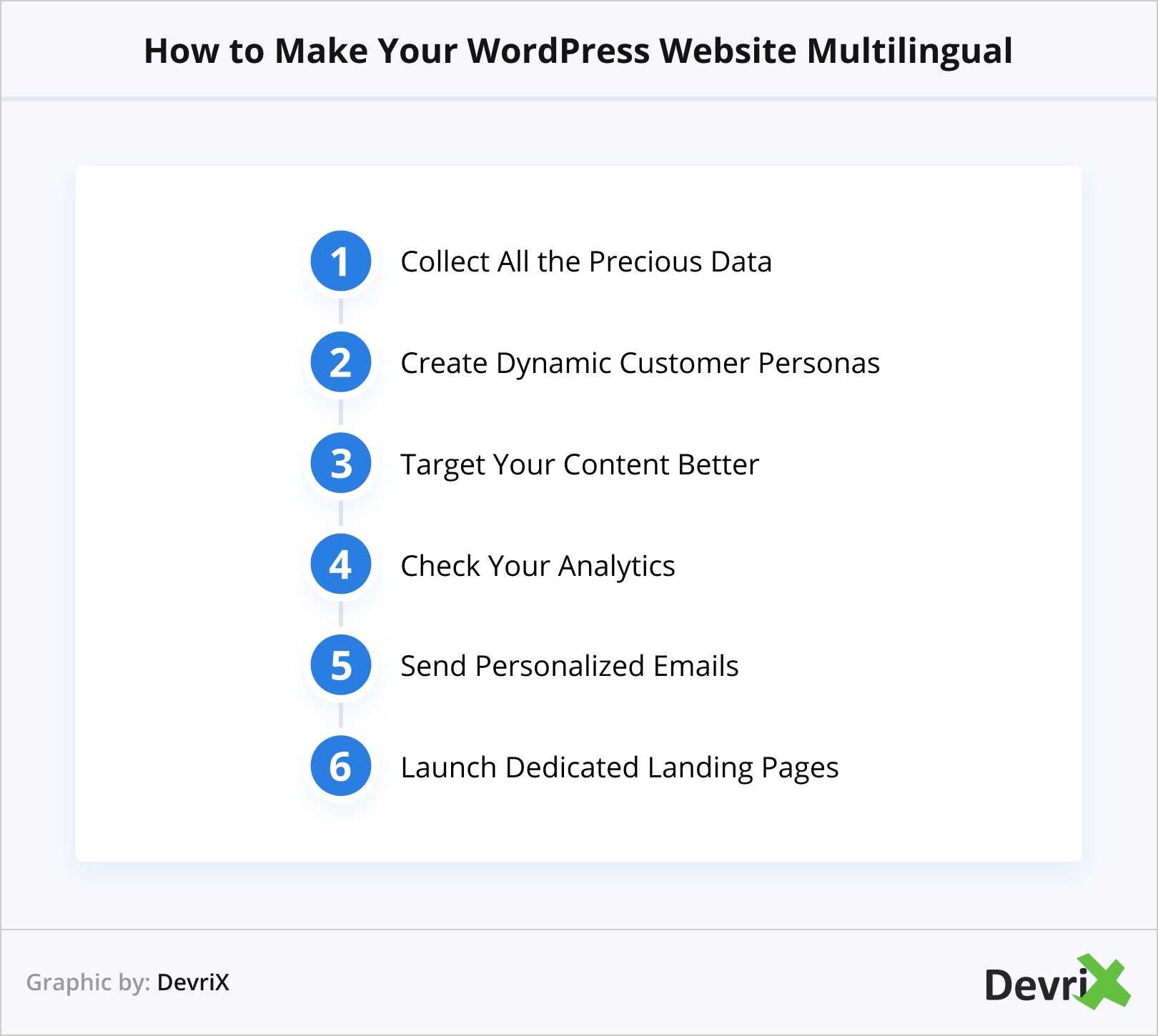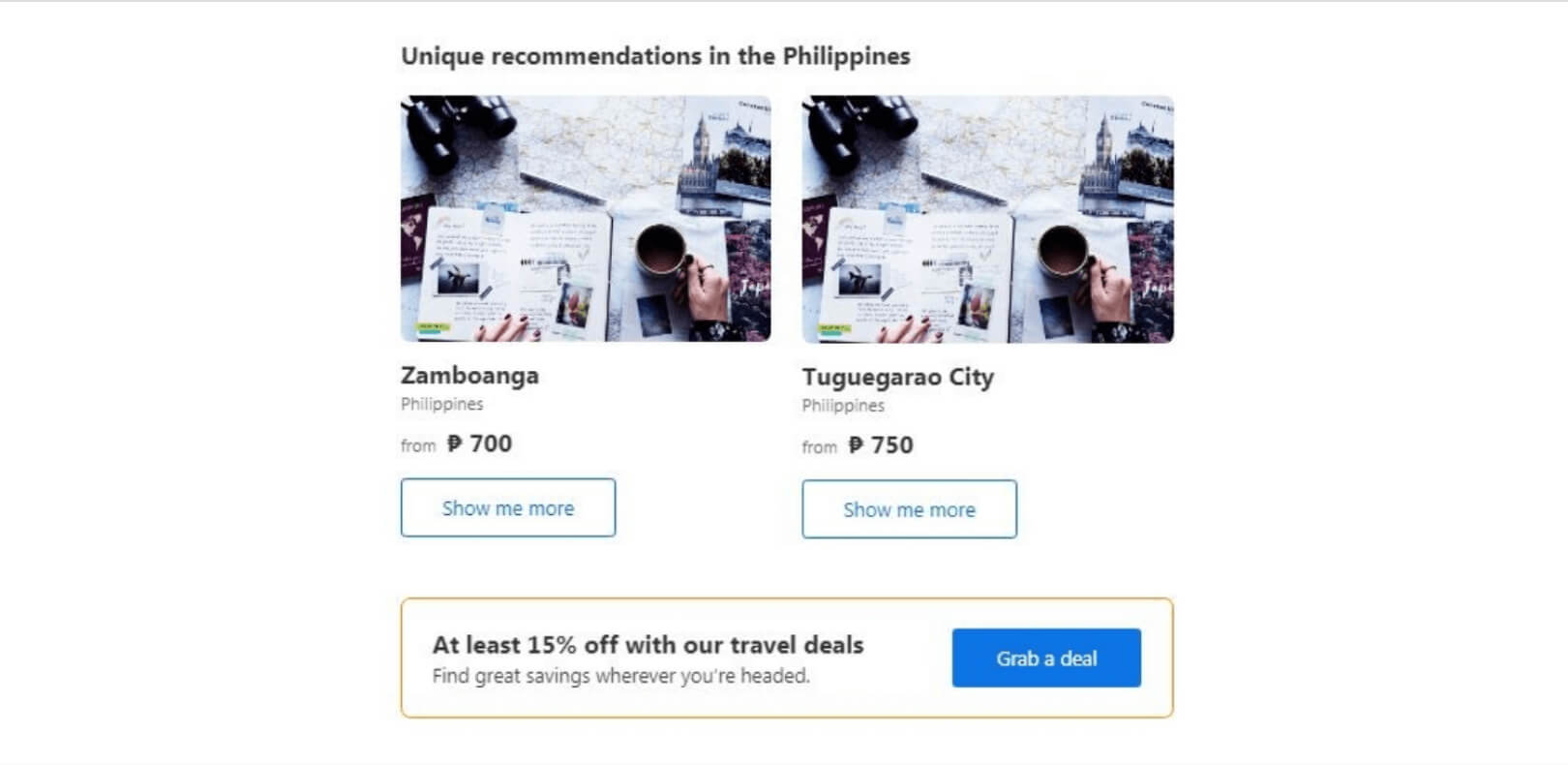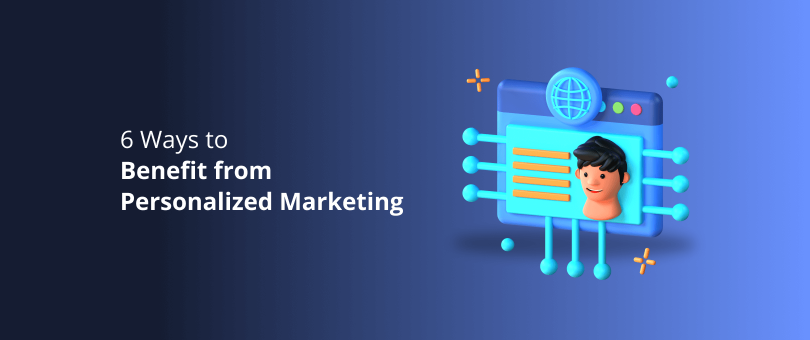Have you ever heard of one-to-one marketing? It’s when a brand targets individual prospects to whom to market its products and services. It’s also known as personalized marketing and it differs from traditional marketing in that it caters to a specific audience.
Traditional marketing usually relies on selling to a wide set of customers through advertisements, chatbots, and emails.
However, today, analytics are more advanced, which is why business owners and marketers can carefully choose the audience that they want to target with their campaigns, newsletters, and ads.
Here are a few examples of personalized marketing campaigns:
- Optimizing your website based on your audience’s preferences.
- Regularly sending targeted email newsletters and campaigns.
- Curating specific content and videos.
- Personalizing your messages and offers.
- Creating dedicated landing pages for small audience segments.
- Sending targeted sale announcements.
- Sending personalized shipping notifications.
- Customizing your customer service messages.

Good to Know Statistics on Personalized Marketing
Here are a few marketing personalization statistics that can be helpful for your strategy and give you an insight into its superpowers and what you can expect by incorporating them:
- According to Instapage, 82% of marketers noticed an increase in open rates when email personalization is applied.
- Hubspot found that personalized CTAs convert 202% better than usual Calls to Action.
- SaleCycle reports that 59% of their respondents state that the way email marketing is done influences their buying behavior.
- According to SmarterHQ, 70% of millennials usually get frustrated with brands that send irrelevant emails.
- Statista reports that 90% of U.S. consumers are more into brands that practice marketing content personalization.
- Smart Insights say that 51% of consumers prefer brands to contact them through email compared to other means of communication.
- Forrester reports that 89% of digital businesses such as Netflix, Wells Fargo, Fabletics, Sephora, and even Coca-Cola are investing in marketing personalization.
- According to Salesforce, 76% of consumers are expecting business owners and companies to understand their expectations and needs.
How to Benefit from Personalized Marketing
Now let’s look at some of the ways to benefit from personalized marketing by incorporating it into your campaigns.
- Collect All the Precious Data
- Create Dynamic Customer Personas
- Target Your Content Better
- Check Your Analytics
- Send Personalized Emails
- Launch Dedicated Landing Pages

1. Collect All the Precious Data
Data-driven decision-making is what the future is all about. And marketing is not an exception,
Every decision about your every move should be carefully planned according to the information and insights you have.
By collecting data, you can get to know and understand your customers better. This will help you create accurate customer personas, which will then allow you to create personalized funnels, ads, and approaches.
Gathering your audience’s data will also allow you to see your buyer’s online behavior, habits, and what they are looking for. That’s the foundation of any good marketing strategy and often used by both big companies and small entrepreneurs to understand their customers better.
In order to get the right data and obtain meaningful insights, you need to track it properly and interpret it correctly.
Most services, tools, and content management systems support statistics and analytics functionality that can give you some insights into user behavior and campaign performance.
You can also use reports and data from tools like Google Analytics and Hotjar.
Once you’ve successfully collected all the data, you can now start creating high-quality content and campaigns that would engage your customers. You can also learn more about the different techniques to gather the data.
Another way to obtain insights is to create surveys that prompt your visitors to give feedback. That is also an option supported by many online services.
However, when it comes to collecting any type of data, you should strive to balance marketing personalization and privacy.
This way, you can provide a personalized experience without violating the user’s personal space, and/or betraying their trust.
To that end, make sure to always ask for consent and follow the laws and regulations that apply for the user’s location.
2. Create Dynamic Customer Personas
Creating customer personas is a well-known way to add a personal touch to marketing strategies. In fact, they are one of the engines of personalized marketing.
Buyer personas are semi-fictional customer profiles that represent your ideal clients, including their qualities, demographics, professions, how and why they use the product, and so on, and so forth.
Personas allow you not only to target your marketing message with precision, but to effectively communicate with your audience This can help increase brand loyalty and lifetime value.
This also helps brands better understand their perfect customers.
You can also use the data that you have collected to segment your customers based on their gender, location, age, pain points, interests, and income. Look at your current buyers’ demographics so you can better understand what they need and what challenges they are facing. This will help you build a roadmap of how your business can reach out to each persona, and best cater to their needs.
3. Target Your Content Better
Once you have created your customer personas, it’s time to focus on the content that you will use to attract their attention.
Find out what your customers need and what they search for online and create high-quality content that you know they would be interested in reading and sharing.
Make sure to properly map out your content across the marketing funnel so you will be able to cater to each customer’s specific needs and interests.
This way, you can benefit from personalized marketing on each touchpoint with the client.
You should also make sure that your content is SEO-friendly, and that it has a chance to rank on the first pages of search engines.
When researching viable products, services, and solutions, or trying to fix a pain point, most customers use search engines such as Google, Bing, DuckDuckGo, and Yahoo (but let’s face it, it’s mostly Google).
That’s why, SEO should be a top priority in your personalized marketing strategy.
To ensure your audience can discover your brand in the relevant SERPs, you should research what keywords they are using and with what intent.
This way, you can create content that matches their needs and feels like it was published just for them.
4. Check Your Analytics
You have to see who your audience is and check out what they are doing on your site, social media pages, or apps.
Track their actions and communicate with them based on their recent activity. You can also use this information to advertise based on their online behavior.
Additionally, you can also highlight the pages and products that your visitors recently viewed.
Analytics platforms can help you with the collection of data that you can use to create personalized content and campaigns.
The data that these tools collect is the one that answers most of your questions about your customers, such as what they do when they are online, what services and products they are into, and who they are.
Some of the platforms that you can use for this include Heap Analytics, Google Analytics, and Crazy Egg.
These will allow you to personalize your digital marketing campaigns, and provide a unique user experience to your customers.
5. Send Personalized Emails
Emailing is a great way to communicate with your customers, which is why you should personalize your messages based on the data you have about each customer.
You can create segmented email lists and build your email messages based on the targets and goals you have for each audience.
In fact, even automated and transactional emails can be adapted to contribute to your personalized marketing experience.
Furthermore, if you are practicing account-based marketing, you can build entire personalized email campaigns, aiming to convert a group of similar clients.
Of course, you can also personalize your newsletters, based on the client’s preferences, engagement, and browsing behavior.
However, according to Neil Patel, only “5% of companies personalize their email marketing campaigns extensively”.
You definitely would want to be a part of this number if you want to stand out, which is why you should work on email personalization. Instapage also states that consumers are more likely to open an email and even respond to it or act on it if they feel like the email is especially directed at them.
You can send emails based on segmentation and behavioral triggers, just like how Coursera and Booking.com do with their email newsletters. Address customers by their name and send them a greeting during their birthdays. Make sure to include a CTA so they’d know where and how to respond to your email.
6. Launch Dedicated Landing Pages
A landing page is a dedicated page on a website that opens when an online user clicks on a marketing promotion, online advertisement, search engine optimized result, or email.
This can be used for your PPC campaigns as they help lead targeted traffic to this specific page. This usually helps the user reach their end goal, and allows them to find what they need and act on it right away. It also helps build credibility and improve targeted messaging.
Create a targeted landing page for your products, services, special offers, and discounts. Make it as detailed and personalized to your customer personas as possible so they can turn into conversions. A well-built landing page will also help you establish your target audience a lot better.
This way, the user can benefit from a personalized marketing experience, and you can look forward to more conversions.
Examples of Personalized Marketing
We’ve listed a few examples of personalized marketing that you can take inspiration from. Take a look below and see how marketing personalization was used successfully.
Coca-Cola

Coca-Cola’s “Share a Coke” campaign was widely accepted and appreciated by consumers from all over the world. You can get a bottle of Coke with your name printed on it. This made people feel like the bottle that they are drinking was specially made for them.
The campaign was launched in 2014 and has been sold in over 80 countries since then. They expanded the campaign in 2015, adding 750 more nicknames to the 250 that they initially started with.
Amazon

Amazon benefits from personalized marketing by analyzing their customers’ past buying behavior and browsing history. They then use this data to recommend products that they know their customers may like and are most likely to purchase.
They tend to amp up this strategy during the holidays, as they maximize their algorithms to perfectly match the consumers’ needs and wants.
Booking.com

Booking.com sends personalized emails to their newsletter subscribers every now and then. They use their algorithm to see where you are from and what you have booked before. They then suggest locations that you can visit and travel to in the future.. Every travel and booking suggestion is unique to the person that they email.
Coursera

Coursera is a website where you can hone your skills by taking different courses and earn your degree and certificate all from the comfort of your own home.
They send email newsletters to their subscribers and suggest courses that they think the receiver would like to take.
Coursera takes a look at your browsing history, online behavior, and past courses that you’ve taken a look at and suggests new ones that they think you’d fancy.
Conclusion
Marketing personalization can further help you successfully convert your leads. By following the steps we have given above, you can start your journey and benefit from personalized marketing.
Let your customers know that they are valued and that you are listening to them closely!
